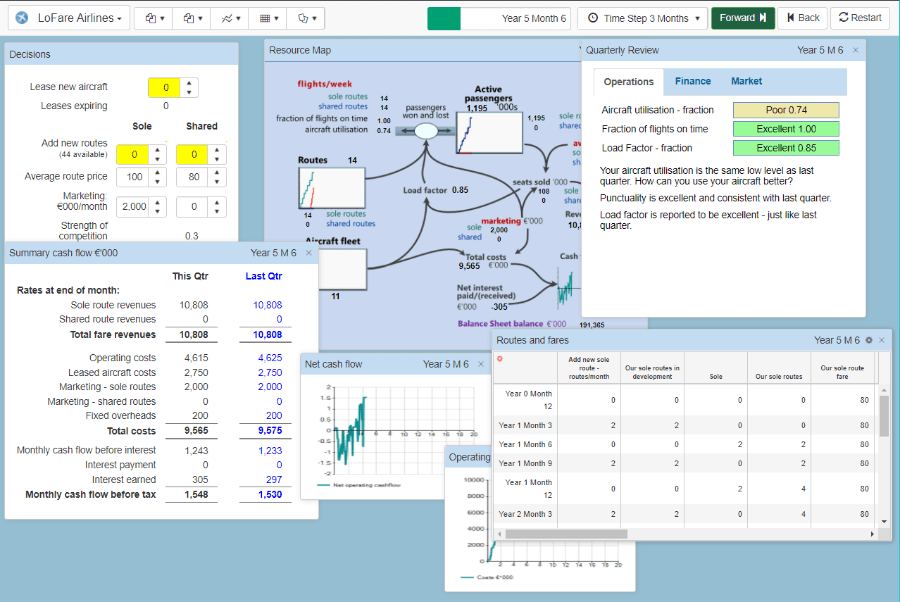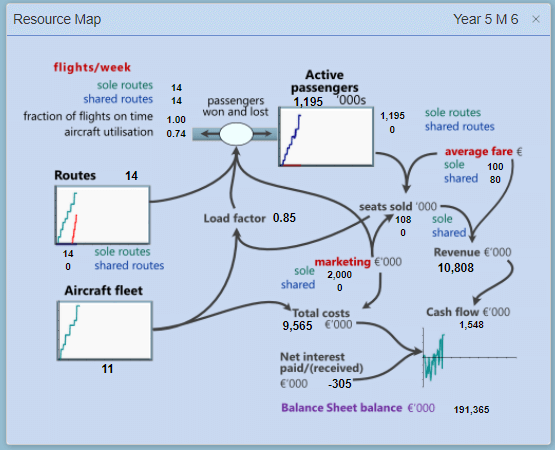LoFare Airlines
Build a low fare airlines business
This game is ideal for use in small teams. The industry setting and business model is familiar to just about everyone, making it easy for any audience to understand and relate to the game.
The game plays out business performance over a long enough time-scale to experience the complexity of strategy and decision-making. Each quarter, teams need to open new routes before competitors do, and provide enough aircraft to serve those routes. And they must set pricing and marketing that encourages new customers, while making sure they stay ahead of competitors and remain profitable.
Teams build and operate a low-fare airline at any time from the birth of the industry to its maturity - a total of 20 years, though you can run shorter periods within that life-cycle!
Teams The game is best used by teams of no more than 5 people in break-out rooms, but short games can also be used by smaller teams (3 is ideal) within a larger class-room. Teams dispersed over different locations can play the game together by using conferencing systems that enable screen-sharing, e.g. Microsoft Teams or Zoom.
Strategy choices There is no fixed 'market size' out there, and no point doing 'market forecasts' - market growth depends on how fast you and rival airlines develop the opportunity. Early in the market's life, you have some choices, such as:
- Open a few routes and add some aircraft, then price just low enough to keep the aircraft 'load factor' (fraction of available seats sold) high, which will make sure you are profitable.
- Or you could be more ambitious, opening routes as fast as you can, adding aircraft quickly and pricing much lower than the big full-service airlines to create and capture the huge market potential, and to stay ahead of low-fare competitors.
As the market matures, you have other choices, such as whether to keep trying to take business from other low-fare and full-service airlines, or switch to a strategy of defending what you have and delivering strong cash-flow.
To deliver strong, profitable growth, teams must:
- assess the scale and profit potential of the emerging market opportunity
balance efforts to grow customers and sales with the capacity to serve them well
*... but make sure capacity is fully utilised to remain financially viable - select the right approach to competitors - being aggressive if that would grow strong cash flows, but more cautious when open warfare risks damaging the business
** Scenario challenges** The LoFare Airline simulation allows teams to tackle these issues from several different situations - a start-up business trying to capture a very large opportunity before others do so, a later entrant that wants to catch and overtake competitors who are already driving forward quickly, or a large and established business in a mature market with little remaining growth. The game can also be set up with competitive conditions that range from rather gentle to very aggressive.

Features
Initial conditions
Teams take on the role of the executive management for a low-fare airline – either starting a new business from nothing, or taking on a business that has already been running for some years.
- Starting a new airline, users can choose the competitive intensity of the industry they will be up against, and can also choose for rivals to start some time after they do.
- Running an existing airline, users can choose from a set of pre-defined challenges, each with a unique set of conditions, both for the business itself and for the market and competitors.
The business is self-contained – not part of a corporate structure with other businesses. The airline is initially competing mostly with full-service airlines, who charge much higher prices, but other low-cost competitors may develop.
The simulation runs for 20 years, with quarterly decisions, but interesting strategies can be run over just a few years, from different parts of the 20-year time-frame.
Objectives can be chosen by instructors or by teams themselves. One such objective can be simple business growth – for example, grow the largest airline possible over 5 years. However, profitable business growth is a more realistic objective. As the market matures, teams will do well simply to stay profitable!
Competition from other low-fare airlines can be disabled, or set at different levels of intensity. This sets the rate at which competitors open new routes, how aggressively they start services on routes that the user’s airline already operate, and how aggressive they are on price. Competition can start immediately, or some time after your business gets going. There is no competition between different team-PCs, so each team’s performances reflects their own expertise.
| Feature List | |
|---|---|
| DECISIONS | Decisions come in two levels:
In addition, competing low-fare airlines can be activated (as well as competition from full service airlines), and their competitive aggression can be varied. If low-fare competitors are active, decisions for opening routes, marketing and fares are split so players can make different choices on routes they operate alone and others where low-fare competitors are active. Teams choose when to run forward and the simulation runs forward one month with each step, or teams can choose to repeat decisions over several months. A 'Go back' option allows previous decisions to be revised an alternative strategies explored. |
| CHALLENGES | Four challenges included - part played scenarios that provide different situations for students to work with. |
| SAVE CHALLENGES | Teams can save the game at any point, to explore alternative strategies. |
| RESOURCE MAP | A 'Resource Map' of the business architecture showing key resource relationships is available in simple and expanded form. |
| REPORTS | Numerical reports showing relevant financial and operational data. |
| GRAPHS | Preset graphs showing the history of key data items. Additionally, Any item appearing in a table can be represented as a graph - simply double click on the table heading. |
| TABLE DATA | Tables show history of financial and service data, as well as a single table of all public data and one of user decsions. Tables can be exported in CSV format to enable analysis. |
| SAVE COMMENTS WITH GAMES | Can add comments to games either for display in games list or in a "Game Notepad". |
| COPY TO OTHER APPLICATIONS | Use screen capture to obtain images of Reports or Graphs for copying into other applications for inclusion in documents and slide presentations produced. |
| TEACHERS MATERIALS | Event managers materials include the user’s guide as well as instructor's slides and slide notes. |
Uses
This game can be played by individuals or small teams. It plays out business performance over a time-scale that is long enough to experience the complexity of strategy and decision-making. Teams control strategy by making a small number of key decisions, and can progress through the simulation at their own pace, trying alternatives and saving scenarios.
Event materials include the user's guide for students and, for instructor's, slides and slide notes.
The courses in which it may be useful are:
Strategy Dynamics - the business resource-system, interdependence between firm resources, managing functions in harmony (sales and advertising).
Strategy courses or workshops - basics of resource-based view (RBV): connection between resources and performance.
Systems thinking courses or workshops - resource-building and feedback (reinforcing)
Marketing courses or workshops - basics of developing both customers (through advertising) and channels (through sales force), working with limited marketing budgets.
Strategy courses for MBAs or under-graduates. The game offers vital learning about strategy implementation - how to deliver performance through the continuing stream of decisions that build and sustain resources and profitability. The game can therefore be used:
at the start of a Strategy course, to bring to life the decision-making reality faced by management teams
at key points during the course, to make the link from strategy positioning to implementation, the role of resources in driving performance, or the dynamics of competition
as a capstone exercise at the end of a course, to offer a whole business, whole industry view of how strategy and performance play out over time
Executive strategy classes. The game is a great addition to executive classes, where again it makes a strong bridge from the principles of strategy positioning to the continuous stream of decisions needed to translate that strategy into performance.
Strategy Dynamics courses. The game is built on rock-solid foundations explained in the book Strategy Dynamics Essentials and taught in our online Strategy Dynamics course. Strategy Dynamics lays out the links from resources to performance, and the growth and interdependence between resources in the business system. The frameworks are simple enough in principle, but must be experienced to be truly understood, so the LoFare Airline game offers a powerful learning opportunity for students and class participants to gain that experience.
Key learning points
Much has been written about the "positioning" of low-fare airlines, compared with full-service operators - how low pricing and frequent, reliable flights to many destinations attracts many more customers. But many have tried this strategy, and most failed (48 out of 60 in Europe for example!), so positioning is not enough. The game offers learning about how to implement strategy over time – assessing the business and its market, setting appropriate objectives, then making choices that steer the strategy to deliver those results.
Further learning focuses on how to manage strategy against competitors, and as conditions change over an industry's lifecycle.
Like all our games, LoFare Airlines demonstrates the simple, standard rules of strategy and performance:
- Performance over time depends on the organisations resources
- Those resources are won and lost over time
- Growth depends on existing resources, management choices and competitive factors
This game also exposes some other specific and important learning points:
- Strategy is often more about creating and capturing a potential opportunity than it is about capturing 'market share'’ of some market that already exists
- Competition is often about competing for mark access (routes in this case) – retail store chains face similar challenges
- Strategy is about choices – whether to drive for growth or not, whether to take on competitors or seek a quieter life
- Management of strategy must adapt as industry conditions change – from the small initial opportunity, through rapid growth with intense competition, to a mature end-game
- It is very hard to sustain profitable growth when intense rivalry is competing away good prices and hitting profit margins. Simply sustaining profits is an achievement in these cases.

Reviews

Based closely on the development of the low fare airlines industry in Europe, this game can be played at varying levels of complexity.
Can your team build a successful airline quickly in this intensively competitive industry? Can you achieve the profitable growth and market domination of firms like Ryanair (Europe), Southwest (USA) or Air Asia (Far East) – or will you crash and die like most firms in the industry?
Play a demo
Teachers can request access to full game and inspection documentation for evaluation